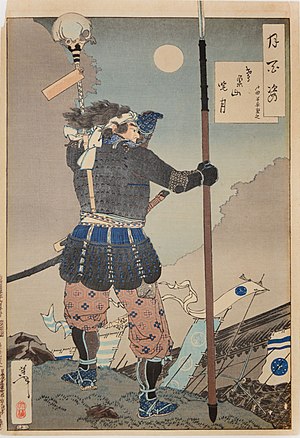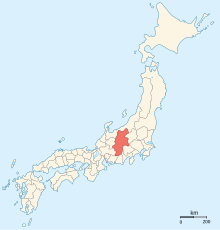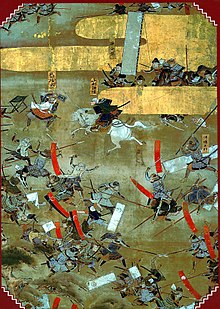
Takeda Shingen was daimyo of Kai Province during the Sengoku period of Japan. Known as the "Tiger of Kai", he was one of the most powerful daimyo of the late Sengoku period, and credited with exceptional military prestige. Shingen was based in a poor area with little arable land and no access to the sea, but he became one of Japan's leading daimyo. His skills are highly esteemed and on par with Mōri Motonari.

Akiyama Nobutomo was a samurai during the Sengoku period in Japan. He is known as one of the "Twenty-Four Generals of Takeda Shingen". Nobutomo also served under Shingen's son, Takeda Katsuyori.

The Battle of Nagashino was a famous battle in Japanese history, fought in 1575 at Nagashino in Mikawa Province. The allied forces of Oda Nobunaga and Tokugawa Ieyasu (38,000) fought against Takeda Katsuyori's forces (15,000) and the allied forces won a crushing victory over the Takeda clan. As a result, Oda Nobunaga's unification of Japan was seen as certain.

Nagashino Castle was a Sengoku period Japanese castle located in what is now Shinshiro, eastern Aichi Prefecture, Japan. It is noteworthy as the site of the crucial Battle of Nagashino between the combined forces of Tokugawa Ieyasu and Oda Nobunaga against Takeda Katsuyori in 1575. The ruins have been protected as a National Historic Site since 1929, the first time a former castle site had received such protection.
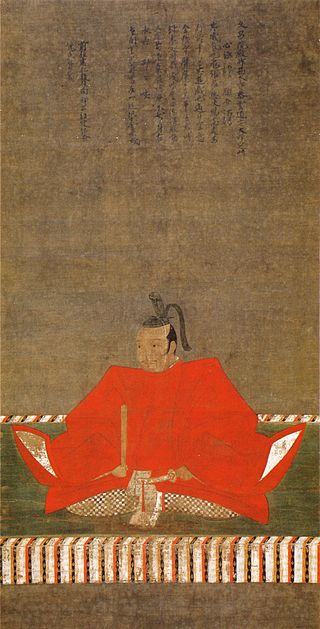
Okudaira Nobumasa, also called Okudaira Sadamasa, was a Japanese daimyō of the Sengoku and early Edo periods. Nobumasa's family considered their origins to have been associated with Mikawa Province. The clan was descended through the Akamatsu from the Murakami-Genji.

Sanada Masayuki was a Japanese Sengoku period lord and daimyō. He was the head of Sanada clan, a regional house of Shinano Province, which became a vassal of the Takeda clan of Kai Province. Along with his father and brothers, Masayuki served the Takeda clan during its heyday, when it was led by Takeda Shingen. After its downfall, Masayuki took the lead of his clan and, despite little power, he managed to establish himself as an independent daimyō under the Toyotomi regime through skillful political maneuvers amidst the powerful Tokugawa, Hojō and Uesugi clans.

Takeda Katsuyori was a Japanese daimyō of the Sengoku period, who was famed as the head of the Takeda clan and the successor to the legendary warlord Takeda Shingen. He was son in law of Hojo Ujiyasu.

Anayama Nobutada, also known as Anayama Genba Nobukimi, Baisetsu Nobutada or Anayama Baisetsu, was a Japanese samurai. He became famous as one of the "Twenty-Four Generals of Takeda Shingen". He was lord of Yokoyama Castle and govern on Ejiri Castle at Suruga Province

Kōsaka Masanobu also known as Kasuga Toratsuna was a Japanese samurai warrior of the Sengoku period. He was known as one of the "Twenty-Four Generals of Takeda Shingen". He is often credited as the original author of Kōyō Gunkan, which records the history of the Takeda family and their military tactics.
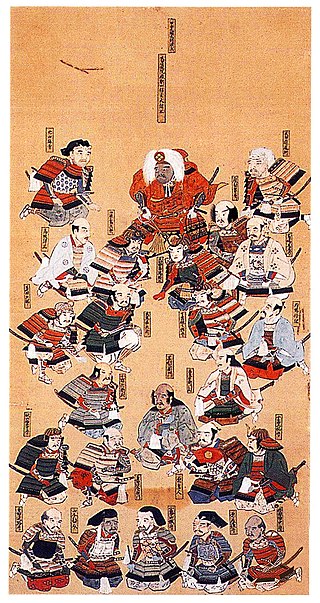
The Twenty-Four Generals were just one of many historically famous groupings of battle commanders from Japan's Sengoku Period. These Twenty-Four were the most trusted companions of Takeda Shingen. A third of them died at the famous Battle of Nagashino in 1575 when they led the Takeda forces against Oda Nobunaga. When Takeda Katsuyori committed suicide in 1582, declaring the end of the Takeda clan, only three of them were still serving under the Takeda.

The Takeda Clan was a Japanese samurai clan active from the late Heian period until the late 16th century. The clan was historically based in Kai Province in present-day Yamanashi Prefecture. The clan reached its greatest influence under the rule of Takeda Shingen, one of the most famous rulers of the period.
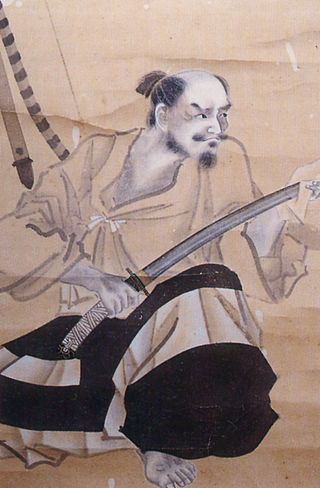
Baba Nobuharu, also known as Baba Nobufusa, was a Japanese samurai of the Sengoku period. He was known as one of the "Twenty-Four Generals of Takeda Shingen". When Takeda Shingen took Fukashi castle in 1550, he entrusted it to Baba.
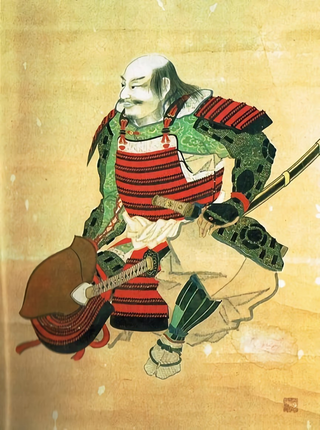
Naitō Masatoyo also known as Naitō Masahide was a Japanese samurai of the Sengoku period. He was known as one of the "Twenty-Four Generals of Takeda Shingen". Masatoyo was the second son of Takeda Nobutora's senior retainer, Kudō Toratoyo. He was first called Kudō Sukenaga. The family's fortunes fell when Toratoyo lost favor with Nobutora and was killed by him.

Oyamada Nobushige was a Japanese samurai general in the Takeda army under Takeda Shingen, and later under Takeda Katsuyori. He was known as one of the "Twenty-Four Generals of Takeda Shingen".
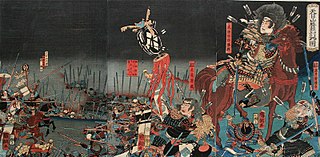
The 1582 Battle of Tenmokuzan in Japan, is regarded as the last stand of the Takeda clan. This was the final attempt by Takeda Katsuyori to resist the combined forces of Tokugawa Ieyasu and Oda Nobunaga, who had been campaigning against him for some time. In his bid to hide from his pursuers, Katsuyori burned his fortress at Shinpu Castle and fled into the mountains, to another Takeda stronghold, called Iwadono, held by Oyamada Nobushige, an old Takeda retainer. Katsuyori was denied entry by Oyamada, and committed suicide with his wife, while the last remnant of his army held off their pursuers.
Amari Masatada was a Japanese samurai of the Sengoku period of Feudal Japan. The son and successor of Amari Torayasu, he was a senior retainer of the Takeda clan of Kai Province, and ranked among Takeda Shingen's 'Twenty-four Generals'. Masatada also served as one of Shingen's personal attendants. During Shingen's campaign in Shinano Province, Masatada served with distinction at the Battle of Kawanakajima in 1561. Masatada later fought at the Battle of Mikatagahara as a senior Takeda officer. By the year of 1563 Masatada went on to fight at the Battle of Usuigatoge and Musashi Matsuyama, but was killed a year later in what would be defined as rare for any standard samurai: a horse riding accident. There is one incident which gave Masatada a stronger name for himself despite being rather eccentric in nature: when Masatada had confronted one of his wounded retainers who suffered from physical bleeding that would not cease flowing, he advised him to drink horse feces and water to support the clotting of his blood — considered among Japanese culture as a folklore. The man was expectingly hesitant in doing so, but when Masatada himself consumed some of the concoction, he was encouraged to follow suit and reportedly recovered.

The Yonekura clan was a cadet branch of the Takeda clan of Kai Province, some members of whom rose to positions of importance within the administration of the Tokugawa shogunate in mid-Edo period Japan.
The Samurai's Tale, by Erik Christian Haugaard, is a fiction novel published by Houghton Mifflin Company in 1984.
Lady Otsuya was a Japanese female samurai (onna-musha) from the Sengoku period. She was the aunt of the famous samurai Oda Nobunaga, the wife of Tōyama Kagetō and foster mother of Oda Katsunaga. She was the ruler of Iwamura Castle until the last days of her life.
Matsuhime or Shinsho-ni (信松尼) was a Japanese noblewoman who was a member of the Takeda clan, an important samurai family of the Sengoku period. She was the daughter of Takeda Shingen and wife of Oda Nobutada. She is best known for trying to strengthen an ailing alliance between Takeda and Oda, two rival families. Matsu is also known for her rightful love and undying devotion to Oda Nobutada, which is considered unusual for the time period. A mountain pass is named Matsuhime Tōge in her honor due to her having used the path to escape Oda Nobunaga's army. The Shinsho-in temple in Hachioji (Tokyo) preserves to this day a wooden statue of Matsuhime and the naginata (polearm) she wielded.
